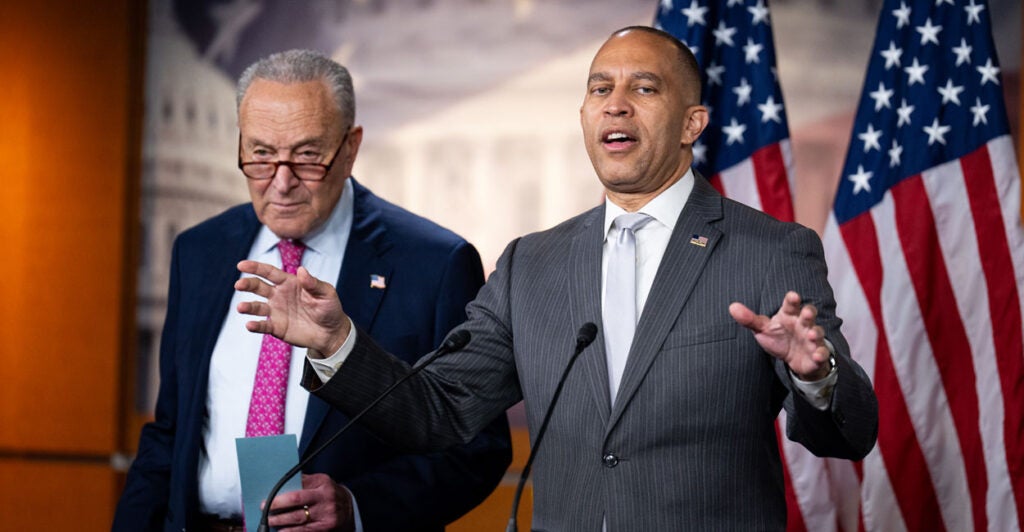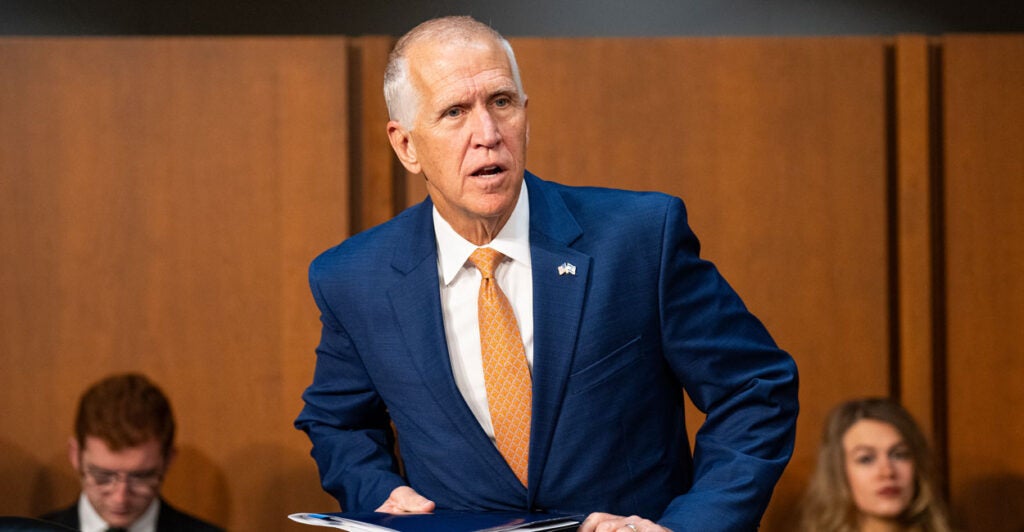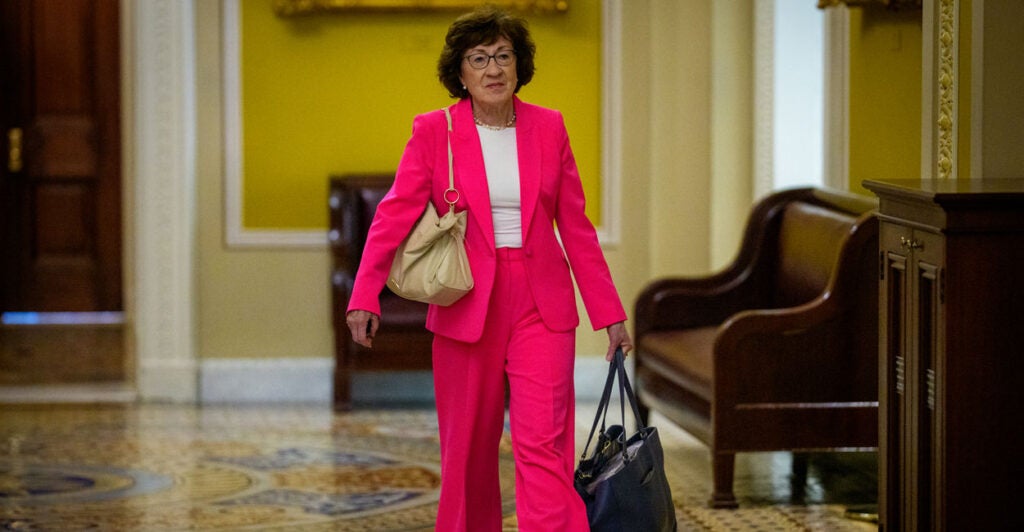House Speaker Mike Johnson and Senate Majority Leader John Thune have delivered on the biggest legislative promises of the Republican Party with last week’s passage of the “big, beautiful bill”—extending the 2017 tax cuts and funding border security.
But the Republican-controlled Congress’ budget fights are far from over. Here’s what to watch in the coming months.
Appropriations: A Shutdown Showdown
Congress has until Oct. 1 to fund the federal government and avoid a shutdown. A nasty partisan blame game is likely when Republicans and Democrats try to work together on the 12 budget bills that make up the appropriations process.
While the “big, beautiful” budget reconciliation process set spending levels for “mandatory spending,” Republicans now have to turn toward appropriations, where they’ll need some Democratic assistance to allocate discretionary funds.
Unlike budget reconciliation bills, the appropriations process requires 60 votes to bring a bill to the floor in the Senate if the minority forces the issue.
Congress passed a continuing resolution in March to continue to fund the government along the Biden administration’s parameters, but that resolution is set to expire at the end of the fiscal year on Sept. 30.
 Senate Minority Leader Chuck Schumer (left) and House Minority Leader Hakeem Jeffries, both D-N.Y. (Bill Clark/CQ-Roll Call via Getty Images)
Senate Minority Leader Chuck Schumer (left) and House Minority Leader Hakeem Jeffries, both D-N.Y. (Bill Clark/CQ-Roll Call via Getty Images)The process will be far from easy. Democrat congressional leadership received brutal backlash for allowing the March continuing resolution to pass, leading to shouting matches at town halls and calls for a change in leadership.
“I think Senate Democrats have to sit down and take a look and decide whether or not Chuck Schumer is the one to lead in this moment,” firebrand Rep. Jasmine Crockett, D-Texas, said in March after Senate Minority Leader Chuck Schumer, D-N.Y., voted for the continuing resolution.
Democrats will likely be under immense pressure from their base and from more strident members of Congress to obstruct the Republicans’ attempts to pass the 12 appropriations bills necessary to fund the government.
More ‘Big, Beautiful Bills’?
It appears Johnson has taken a liking to budget reconciliation bills as a way to enact transformative legislation without Democrat votes.
Shortly after passing the “big, beautiful bill,” Johnson said on TV’s “Fox News Sunday” he would be rolling out even more.
“We’ve been planning a second reconciliation bill for the fall that would be attached to the next fiscal year, and then potentially one in the spring. That’s my plan—three reconciliation bills before this Congress is over,” he said.
Under the Congressional Budget Act of 1974, which created the budget reconciliation process, Congress is generally allowed one reconciliation bill per fiscal year for each budget resolution, which is essentially a nonbinding rough draft for the legislation.
But Johnson is staying mum on what exactly would be in those future bills.
“You’ll see more of us advancing these common-sense principles to deliver that ‘America first’ agenda for the American people,” he said.
Johnson’s proposal of follow-up reconciliation bills may have helped secure the votes of final holdouts in the House. House GOP Conference Chair Lisa McClain, R-Mich., suggested that shortly before the bill’s passage.
Holdouts “wanted to speak with the president, and they wanted to get some assurances from the president that we’re not done, that this process is still going to continue through rescission and through other reconciliations, and obviously, they got those assurances to the point where they feel that they will be voting ‘yes,’” McClain said.
That could mean fiscal hawks were told they would receive a bill that would enshrine deeper spending cuts into law.
But passing a second “big, beautiful bill” might be just as hard as passing the first one.
For one thing, the GOP has succeeded in its main mission of delivering on tax cuts and border security. Without these incentives, it will be difficult to create the same sense of urgency for members to get on board.
A lot of political capital was spent in getting the megabill over the finish line.
When Sen. Thom Tillis, R-N.C., indicated he would not vote for it, President Donald Trump threatened to support a primary challenger against him, which may have precipitated Tillis announcing he would not seek reelection next year.
 Sen. Thom Tillis, R-N.C. (Bill Clark/CQ-Roll Call via Getty Images)
Sen. Thom Tillis, R-N.C. (Bill Clark/CQ-Roll Call via Getty Images)Tillis, who had bucked the party line before, would have nothing to lose anymore if he were to take issue with a follow-up bill.
There’s also Sen. Lisa Murkowski, R-Alaska, who was brought over to a “yes” on the “big, beautiful bill,” but urged the House to reject it.
Murkowski delivered the 50th vote, which allowed Republican leadership to pass the bill with Vice President JD Vance’s tiebreaking vote.
Republican Sens. Rand Paul and Susan Collins also voted against the bill despite the maximum pressure applied by the White House and Senate leadership.
What’s more, Johnson and Thune will have a lot on their plates as they work on appropriations in the coming months. An autumn megabill is ambitious, to say the least.
Codifying DOGE Cuts
Congress has until July 18 to vote for a White House-backed rescissions package that would cancel unspent funds for public broadcasting and foreign aid.
The package, which targets National Public Radio (NPR), the Public Broadcasting Service (PBS), and the U.S. Agency for International Development (USAID) funding, was passed through the House by a 214-212 margin in June.
This legislation could run into trouble in the Senate, where some senators are bristling at cutting funding.
 Sen. Susan Collins, R-Maine (Andrew Harnik/Getty Images)
Sen. Susan Collins, R-Maine (Andrew Harnik/Getty Images)Collins has called purported cuts to AIDS prevention programs in the package “extraordinarily ill-advised and shortsighted” and has floated the idea of “drafting an alternative package of rescissions.”
Despite the fact that the package cuts $9.4 billion—a pittance compared to the federal government’s roughly $7 trillion in spending in 2024 alone—the Senate may soften this rescission package to be sent back to the House for final passage.
The post Congress’ Budget Fights Have Only Just Begun appeared first on The Daily Signal.
.png)















 English (US)
English (US)